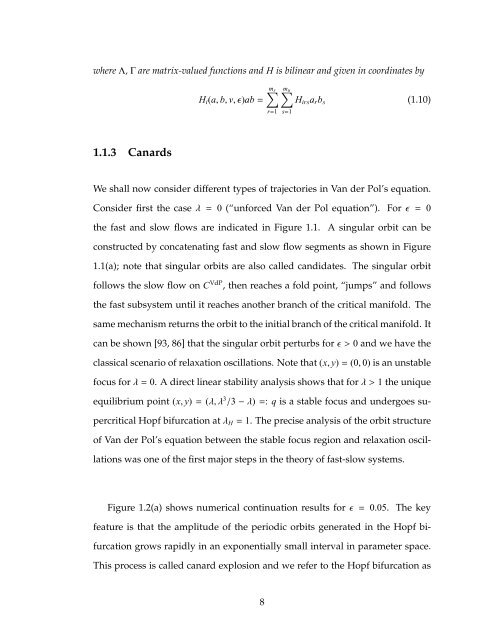multiple time scale dynamics with two fast variables and one slow ...
multiple time scale dynamics with two fast variables and one slow ...
multiple time scale dynamics with two fast variables and one slow ...
You also want an ePaper? Increase the reach of your titles
YUMPU automatically turns print PDFs into web optimized ePapers that Google loves.
whereΛ,Γare matrix-valued functions <strong>and</strong> H is bilinear <strong>and</strong> given in coordinates by<br />
1.1.3 Canards<br />
ms<br />
mu<br />
Hi(a, b, v,ǫ)ab=<br />
r=1<br />
s=1<br />
Hirsarbs<br />
(1.10)<br />
We shall now consider different types of trajectories in Van der Pol’s equation.<br />
Consider first the caseλ = 0 (“unforced Van der Pol equation”). Forǫ = 0<br />
the <strong>fast</strong> <strong>and</strong> <strong>slow</strong> flows are indicated in Figure 1.1. A singular orbit can be<br />
constructed by concatenating <strong>fast</strong> <strong>and</strong> <strong>slow</strong> flow segments as shown in Figure<br />
1.1(a); note that singular orbits are also called c<strong>and</strong>idates. The singular orbit<br />
follows the <strong>slow</strong> flow on C VdP , then reaches a fold point, “jumps” <strong>and</strong> follows<br />
the <strong>fast</strong> subsystem until it reaches another branch of the critical manifold. The<br />
same mechanism returns the orbit to the initial branch of the critical manifold. It<br />
can be shown [93, 86] that the singular orbit perturbs forǫ> 0 <strong>and</strong> we have the<br />
classical scenario of relaxation oscillations. Note that (x, y)=(0, 0) is an unstable<br />
focus forλ=0. A direct linear stability analysis shows that forλ>1 the unique<br />
equilibrium point (x, y)=(λ,λ 3 /3−λ)=: q is a stable focus <strong>and</strong> undergoes su-<br />
percritical Hopf bifurcation atλH= 1. The precise analysis of the orbit structure<br />
of Van der Pol’s equation between the stable focus region <strong>and</strong> relaxation oscil-<br />
lations was <strong>one</strong> of the first major steps in the theory of <strong>fast</strong>-<strong>slow</strong> systems.<br />
Figure 1.2(a) shows numerical continuation results forǫ = 0.05. The key<br />
feature is that the amplitude of the periodic orbits generated in the Hopf bi-<br />
furcation grows rapidly in an exp<strong>one</strong>ntially small interval in parameter space.<br />
This process is called canard explosion <strong>and</strong> we refer to the Hopf bifurcation as<br />
8
















